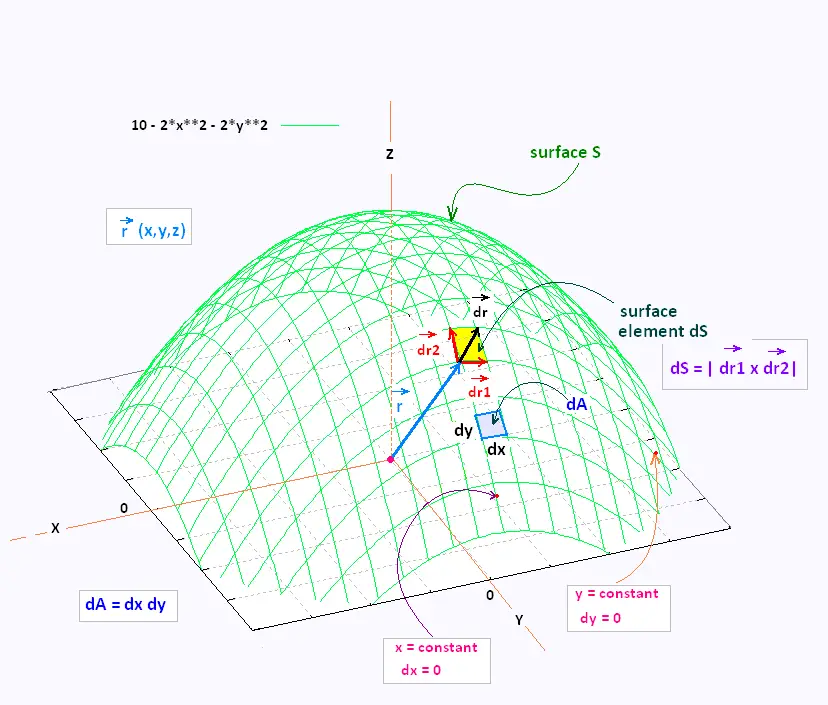Calculus III
Contents
3 Dimensional space
Partial derivatives
Multiple integrals
Vector Functions
Line integrals
Surface integrals
Vector operators
Applications
© The scientific sentence. 2010
|
|
Calculus III:
Surface area
Surface area element
We are going to determine between dS and dA.
Ds is rhe surface element , and dA is the surface area element.
1. Surface area element

The vector position  points
on the surface S. points
on the surface S.
 =
x =
x  +
y +
y  +
z +
z 
Its derivative is:
 =
dx =
dx  +
dy +
dy  +
dz +
dz 
z = f(x,y) → dz = (∂f/∂x)dx + (∂f/∂y))dy
 = =  + +
 . .
 = =  (y = const) = dx (y = const) = dx  +
dz +
dz  =
=
dx  +
((∂f/∂x)dx + (∂f/∂y)dy
) +
((∂f/∂x)dx + (∂f/∂y)dy
) =
=
dx ( + (∂f/∂x) + (∂f/∂x) ) )
Similarly, in the y direction, dx = 0, which leads to:
 =
dy ( =
dy ( + (∂f/∂y) + (∂f/∂y) ) )
Now, let's evaluate dS:
dS = | x x  | = | = |
 |
 |
 |
 |
 |
| dx
|
0
|
dx fx
|
| 0
|
dy
|
dy fy
|
= - dx dy (∂f/∂x)  - dx dy (∂f/∂y)
- dx dy (∂f/∂y)  +
dx dy +
dx dy 
Taking its magnitude:
dS = | x x  | = | =
= |- dx dy (∂f/∂x)  - dx dy (∂f/∂y)
- dx dy (∂f/∂y)  +
dx dy +
dx dy  | = | =
√{[dx dy (∂f/∂x)]2 +
[dx dy (∂f/∂y)]2 +
[dx dy]2} =
dx dy √[(∂f/∂x)2 +
(∂f/∂y)2 +
1] =
dS = √[(∂f/∂x)2 +
(∂f/∂y)2 +
1] dx dy
=
dS = √(fx2 +
fy2 + 1) dx dy
dS = √(fx2 +
fy2 + 1) dx dy
2. Surface area element formula
To integrate a function f(x,y) over a surface S, we project the surface S on the xy-plane to get the corresponding region D, of area element dA = dx dy, where to integrate this function.
∫∫S f(x,y) dS = ∫∫D f(x,y) √(fx2 +
fy2 + 1) dA.
dS changes according to the formula:

|
|